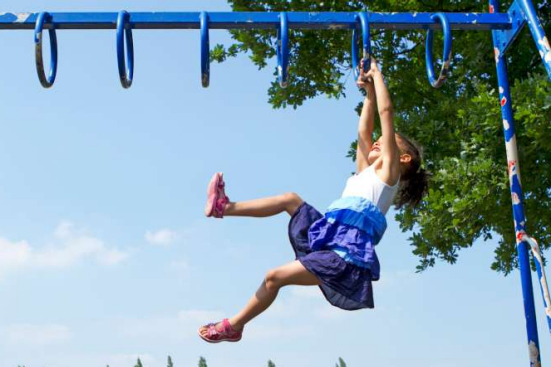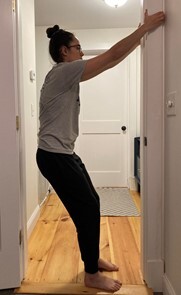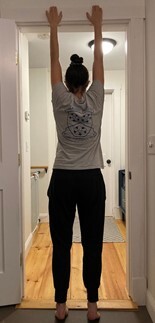Brachiation And Shoulder Health

What do gymnasts, little kids, and monkeys have in common? They are all great at brachiation (“brachium” is Latin for “arm”), which is a means of locomotion by swinging from one hand to the other. Monkeys use brachiation to swing among tree branches, children brachiate on jungle gyms, and gymnasts exhibit impressive feats of brachiation on the uneven bars. With modern society being geared towards terrestrial versus arboreal activities, most of us probably haven’t swung by our arms in awhile. But believe it or not, our shoulder girdles are meant to be used for hanging and swinging and brachiating can arguably be an important part of maintaining shoulder health.
As our hominid ancestors evolved, they started venturing off the ground and up into the trees. To adapt to the demands of climbing and suspensory activities, their upper extremities went through morphological changes as well. Fingers became longer and thumbs shorter for stronger gripping and the shape of the wrist and shoulder joints developed to allow more mobility. Additionally, having shoulder blades positioned more on the backside of a wider and shallower trunk, promoted a larger range of shoulder motion. This enabled our predecessors to use their arms for reaching and manipulating objects. These evolutionary changes to the shoulder girdle that enabled brachiation and reaching are still present in the modern human and the shoulder joint remains the most mobile joint in our body.
If the shoulders are meant to be so mobile, why do so many people experience stiffness and limited range of motion in their shoulders? It is quite likely that our modern lifestyles are playing a major role in the pervasiveness of shoulder impairments. We spend most of the day engaged in activities right in front of us, such as driving, cooking, computer use, texting, walking, etc. Few of these activities necessitate reaching overhead, let alone hanging by our arms. Therefore, our shoulder joints are not regularly being moved throughout their full range and our muscles, tendons, and ligaments are rarely being fully stretched. Additionally, the tendency to perform many of the above activities in poor posture further contributes to muscle imbalances. On the rare occasion when one may need to reach or lift something overhead, the shoulders are consequently not used to performing that action. This can often result in poor mechanics, muscle tendon strain, and eventually pain.
Introducing some form of brachiation to your daily routine is one way to maintain the natural mobility of the shoulder joints and improve the balance of muscle tension and control around the shoulder girdle. The suspension involved in brachiating stretches several shoulder girdle muscles that are often tight and contribute to poor shoulder mechanics, such as the pectorals and latissimus dorsi. Adding a swinging motion improves the strength and coordination of the shoulder muscles, which must lengthen and contract with control in order to propel the body while maintaining shoulder stability. Thus, brachiating is a great way to improve and maintain both shoulder mobility and strength.
Our bodies are meant to move and the key to having resilient and healthy joints and tissues is maintaining variability in movement and loading. As we get older, our “repertoire” of movement tends to become progressively smaller, so our bodies become stiffer. We can remedy this by sprinkling in exercises or activities that involve movements or positions we don’t normally do during our daily life. So if you sit at a desk with your arms at your sides, typing away on a computer all day, raise those arms up every once in a while and try some brachiating! You just may start to notice a little less stiffness and tightness in your shoulders, back, and neck.
Here are some simple and modified ways to start channeling your inner primate and improve your shoulder health with brachiation! (However, if you are experiencing shoulder pain, make sure you check with your physical therapist or athletic trainer before attempting a new exercise).
Get your shoulders accustomed to some light traction in a lower range of elevation with a doorway hang. Focus on breathing (particularly full exhalations) and keeping your ribcage down. 
Start to challenge your shoulders a little more by hanging from the top of the doorway. This stretches the shoulders in a fully elevated position and you can control how much of your body weight you are supporting by bending your knees. Try some gentle swaying side to side or vary your grip by having your hands closer or farther apart. Remember to breathe and keep your ribcage down.

The next progression would be to fully hang from a sturdy bar (perhaps at your local playground!), thus suspending your full body weight. Again, start to gently sway your body. Perhaps experiment with hanging from one arm. Play around with it and do what feels good!


